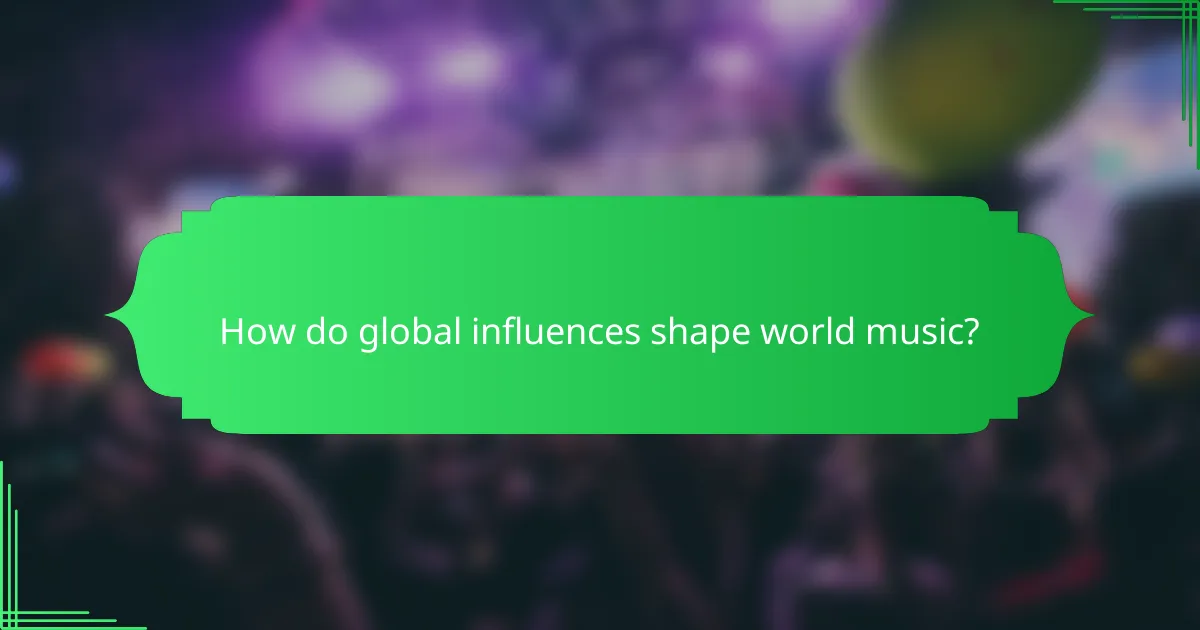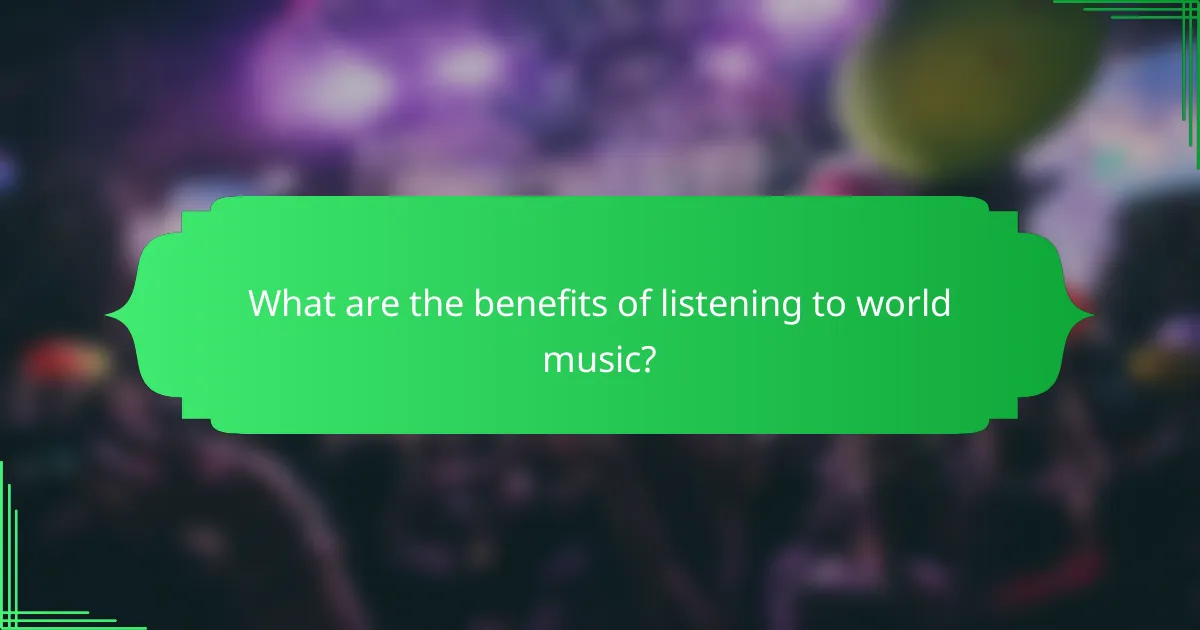World music serves as a vibrant celebration of cultural diversity, showcasing a multitude of musical styles and traditions from around the globe. By incorporating a rich variety of instruments and blending global influences, it fosters innovation and collaboration among artists, resulting in unique sounds that resonate across different communities.

How does world music promote cultural diversity in Canada?
World music promotes cultural diversity in Canada by showcasing a wide array of musical styles and traditions from various cultures, fostering appreciation and understanding among different communities. This rich tapestry of sounds encourages collaboration and innovation, allowing artists to blend influences and create new forms of expression.
Celebration of Indigenous music
Indigenous music in Canada plays a crucial role in promoting cultural diversity by preserving and sharing traditional sounds and stories. Events like powwows and festivals highlight Indigenous artists, allowing them to showcase their unique instruments, such as drums and flutes, while educating audiences about their heritage.
Organizations and initiatives aimed at revitalizing Indigenous music help to ensure that these cultural expressions are not only celebrated but also passed down through generations. This fosters a deeper understanding of Indigenous cultures among non-Indigenous Canadians.
Integration of immigrant musical traditions
Canada’s multicultural landscape allows for the integration of various immigrant musical traditions, enriching the national music scene. Genres such as reggae, salsa, and bhangra have found a home in Canadian cities, often leading to the creation of hybrid styles that reflect the diverse backgrounds of the artists.
Community events and cultural festivals frequently feature immigrant musicians, providing platforms for them to share their heritage and connect with wider audiences. This integration not only promotes cultural diversity but also encourages social cohesion and mutual respect among different communities.
Collaboration among diverse artists
Collaboration among diverse artists is a hallmark of Canada’s music scene, where musicians from different backgrounds come together to create innovative works. These collaborations often result in unique fusions of styles, such as blending traditional folk with contemporary pop, which can attract a broader audience.
Music collectives and cross-cultural projects are increasingly common, providing opportunities for artists to learn from one another and experiment with new sounds. This collaborative spirit not only enhances the richness of Canadian music but also reinforces the importance of cultural diversity in artistic expression.

What instruments are commonly used in world music?
World music features a diverse array of instruments that reflect the cultural heritage and traditions of various regions. Commonly used instruments include drums, stringed instruments, and wind instruments, each contributing unique sounds and rhythms to the music of their respective cultures.
Traditional African drums
Traditional African drums are central to the continent’s music, often used in ceremonies, celebrations, and storytelling. Instruments like the djembe, talking drum, and conga vary in size and shape, producing distinct tones and rhythms.
These drums are typically made from wood and animal skin, and they are played with the hands or sticks. The communal aspect of drumming is significant, as it often involves group participation, creating a powerful connection among players and listeners.
Indian sitar
The sitar is a prominent string instrument in Indian classical music, known for its rich, resonant sound. It features a long neck, a gourd-shaped body, and multiple strings, which allow for intricate melodies and improvisation.
Playing the sitar requires skill in finger positioning and strumming techniques. Musicians often use a plectrum called a mizrab to pluck the strings, producing a unique tonal quality that is essential to Indian music’s emotional expression.
Latin American marimba
The marimba is a popular percussion instrument in Latin America, particularly in countries like Guatemala and Mexico. It consists of wooden bars of varying lengths that are struck with mallets, producing melodic sounds that are both vibrant and rhythmic.
Often used in folk music and dance, the marimba can be played solo or as part of an ensemble. Its versatility allows it to blend with various musical styles, making it a staple in celebrations and cultural events throughout the region.

How do global influences shape world music?
Global influences shape world music by blending diverse cultural elements, styles, and instruments, creating unique sounds that reflect a fusion of traditions. This interplay enhances musical creativity and broadens the appeal of various genres across different regions.
Fusion genres like Reggaeton
Fusion genres such as Reggaeton exemplify how global influences can create new musical forms. Originating in Puerto Rico, Reggaeton combines Latin rhythms with hip-hop, dancehall, and electronic music, resulting in a vibrant and popular genre worldwide.
This genre often features catchy beats and lyrics in Spanish, making it accessible to a broad audience. The collaboration between artists from different backgrounds has further enriched Reggaeton, incorporating elements from various cultures and musical traditions.
Impact of technology on music distribution
Technology has revolutionized music distribution, allowing artists to reach global audiences more easily than ever before. Streaming platforms like Spotify and Apple Music enable listeners to explore world music from their devices, fostering a greater appreciation for diverse genres.
Social media also plays a crucial role in promoting global music trends, as artists share their work and collaborate across borders. This accessibility can lead to increased exposure for lesser-known genres and artists, enhancing cultural exchange.
Cross-cultural collaborations
Cross-cultural collaborations are a powerful way to blend musical traditions and create innovative sounds. Artists from different countries often come together to produce music that reflects their unique backgrounds while appealing to a global audience.
These collaborations can result in new genres or revitalized traditional forms, as seen in projects that combine African rhythms with Western pop or Indian classical music with electronic beats. Such partnerships not only enrich the music but also promote cultural understanding and appreciation.

What are the benefits of listening to world music?
Listening to world music offers numerous benefits, including enhanced cultural appreciation and emotional enrichment. It exposes listeners to diverse sounds and traditions, fostering a deeper understanding of global cultures.
Enhances cultural understanding
World music introduces listeners to various cultural backgrounds, traditions, and histories. By engaging with different musical styles, individuals can gain insights into the values and experiences of other societies.
For example, listening to African drumming can reveal the significance of rhythm in community gatherings, while traditional Indian classical music may highlight the importance of spirituality in daily life. This exposure can promote empathy and respect for cultural diversity.
Promotes emotional well-being
World music can have a profound impact on emotional health, often evoking feelings of joy, nostalgia, or tranquility. Different genres, such as Brazilian samba or Indian raga, can uplift spirits and provide a sense of connection to others.
Research suggests that music from various cultures can reduce stress and anxiety levels, making it a valuable tool for mental wellness. Incorporating world music into daily routines can enhance mood and promote relaxation.
Encourages creativity and inspiration
Exposure to diverse musical styles can stimulate creativity and inspire new ideas. Artists, writers, and musicians often draw from global influences to enrich their work, leading to innovative expressions.
For instance, a painter might use the vibrant colors associated with Latin American music to influence their artwork, while a filmmaker could incorporate traditional melodies to enhance storytelling. Engaging with world music can open up new avenues for creative exploration.

How can you explore world music in Canada?
Exploring world music in Canada involves engaging with diverse musical traditions through festivals, cultural institutions, and online platforms. Each approach offers unique opportunities to experience the rich tapestry of global sounds and styles.
Attend local music festivals
Canada hosts numerous music festivals celebrating world music, featuring artists from various cultural backgrounds. Events like the Montreal International Jazz Festival and the Vancouver Folk Music Festival showcase a wide range of genres, allowing attendees to experience live performances and discover new artists.
When attending these festivals, consider checking the lineup in advance to identify acts that resonate with your interests. Many festivals also offer workshops and discussions, providing deeper insights into the music and its cultural significance.
Visit cultural centers and museums
Cultural centers and museums across Canada often feature exhibits and performances dedicated to world music. Places like the Canadian Museum of History and the Aga Khan Museum in Toronto provide immersive experiences that highlight the history and diversity of global musical traditions.
Take advantage of guided tours or educational programs offered by these institutions to enhance your understanding. Look for events that include live demonstrations or performances, as these can offer a more engaging way to connect with the music.
Engage with online music platforms
Online music platforms such as Spotify, Apple Music, and YouTube provide access to a vast array of world music. These services often curate playlists that highlight different cultural genres, making it easy to explore new sounds from the comfort of your home.
Consider following artists or playlists that focus on specific regions or styles to receive recommendations tailored to your tastes. Additionally, many platforms feature podcasts and documentaries that delve into the stories behind the music, enriching your listening experience.

What role do music festivals play in showcasing world music?
Music festivals serve as vital platforms for showcasing world music by bringing together diverse artists and audiences, promoting cultural exchange and appreciation. They highlight various musical traditions and styles, allowing attendees to experience a rich tapestry of global sounds.
Highlighting diverse artists
Music festivals often feature a wide array of artists from different cultural backgrounds, showcasing their unique sounds and instrumentation. This diversity not only enriches the festival experience but also fosters a greater understanding of global musical traditions.
For instance, festivals like the WOMAD (World of Music, Arts and Dance) celebrate artists from various countries, offering performances that range from traditional folk to contemporary fusion. Such events encourage collaboration and innovation, as artists blend their musical styles, creating new genres that reflect cultural intersections.
To effectively highlight diverse artists, festival organizers should prioritize inclusivity in their lineups and promote lesser-known musicians alongside established acts. This approach not only enhances the festival’s appeal but also supports emerging talent in the world music scene.
